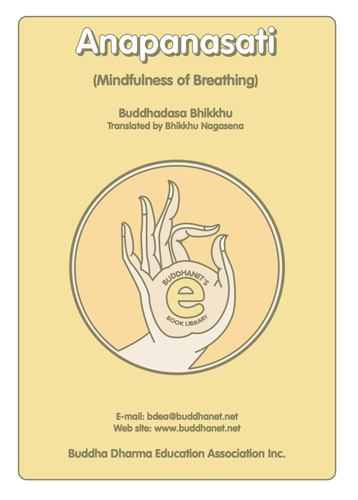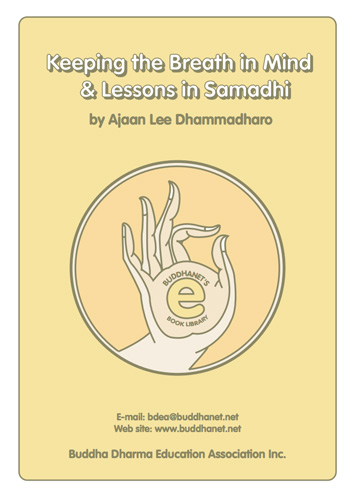 Image search results - "Anapanasati" Image search results - "Anapanasati" |

04_anapanasati_sutta.pdfThe Anapanasati Sutta3833 viewsThe Anapanasati Sutta is not an easy read, although the language itself is quite simple. But its structure is complex and dense, and this complexity raises serious questions about interpretation. The complexity of the structure creates ambiguity. Even the orthodox commentary sees certain passages as capable of different but simultaneous readings, referring to either serenity or insight practice depending on what approach to the practice the practitioner is taking.
We can see how Thich Nhat Hanh can take liberties with the text, but he does so to make the practice explained within it more accessible to ordinary lay people. Are we to assume that this was not the intention of the original compilers? Or can we see the complexity of the sutta as evidence of an attempt to create a discourse that different communities of practitioners could, quite legitimately, read in different ways? In any event, if we are to make sense of this sutta, and extract from it what it has to offer in terms of guidance on the practice, we need to read the structure of the text. It is not just the surface words that convey meaning, but the underlying networks that link the words.
|
|

anapanasati.pdfAnapanasati - Mindfulness of Breathing12455 viewsFor the first time in the English language a comprehensive manual of Buddhist meditation known as anapanasati (the development of mindfulness of breathing) is available. Although this manual is primarily intended for the benefit of monks, it will greatly assist laymen, too, who wish to undertake a course of meditation but who do not have the guidance of a teacher. Originally published in Thai, this manual is one of the major works of the Ven. Buddhadsa Bhikkhu and delivered in 1959 in the form of a series of lectures to monks of Suanmokkha Monastery, Chaiya, Thailand. Ven. Buddhadasa Bhikkhu, a major voice in the Buddhist world, is an accepted master of Buddhist meditation. In constructive positive language, the manual guides the meditator through the 16 steps of anapanasati.
|
|

Anapanasati_appreciation.pdfAnapanasati Sutra Appreciation (MN 118)3064 viewsFulfilling Awareness of the Breath Meditation
This is a concise and straightforward appreciation of the Anapanasati Sutta (MN 118). What makes this appreciation different is the emphasis on personal meditative insight leading to deepening wisdom through practical meditation instruction.
|
|

breathmind.pdfKeeping the Breath in Mind & Lessons in Samadhi6916 viewsThis is a 'how to' book. It teaches the liberation of the mind, not as a mind-boggling theory, but as a very basic skill that starts with keeping the breath in mind. The teachings here are drawn from the works of Ajaan Lee Dhammadharo (1906-61), one of Thailand's most renowned teachers of Buddhist meditation practices. Ajaan Lee was a forest monk - one who prefers to live in the seclusion of the forest and makes his meditation the central theme of his practice - so his teachings grow out of personal, practical experience, although he also makes a point of relating them to standard Buddhist doctrine.
|
|

Mindfulness_Breathing.pdfMindfulness of Breathing3556 viewsThis is a useful anthology of important and pragmatic source material from the Pali Canon and Commentaries on the technique of Anapana, or breath-awareness meditation. It includes the Discourse on Respiration-Mindfulness from the Majjhima Nikaya, commentary from the Vishuddhimagga (Path of Purification), and analyses of other passages and Suttas.
|
|

The_Anapanasati_Sutta_2.pdfThe Anapanasati Sutta4039 viewsA Practical Guide to Mindfulness of Breathing and Tranquil Wisdom Meditation. This is a meditation instruction book, written by an American monk who currently runs the Dhamma Sukha Meditation Center in Missouri. While the subject material is nothing new, the Venerable. offers a different (and somewhat controversial) point of view on the practicing of the Tranquil Wisdom meditation that is well worth the read.
|
|

Wisdom_Develops_Samadhi.pdfWisdom Develops Samadhi5048 viewsAnapanasati Bhavana (developing the awareness of breathing) uses the breath as the objective support of the heart and consists in knowing and mindfulness (sati) of in and out breathing. In becoming aware of breathing, one should at first fix attention on the feeling of the breath at the nose or the palate (roof of the mouth), as it suits one, because this is where the breath initially makes contact, and one may use this as a marker point for holding one's attention. Having done this until one has become skilled, and the in and out breathing becomes finer and finer, one will progressively come to know and understand the nature of the contact of in and out breathing, until it seems that the breathing is located either in the middle of the chest or the solar plexus. After this one must just fix one's attention on breathing at that place and one must no longer be concerned about fixing attention on the breathing at the tip of the nose or the palate, nor about following it in and out with awareness…
|
|
|
|
